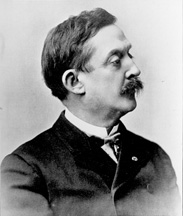I'm almost afraid to say anything and possibly jinx things, but we're finally starting to have some decent temperatures around here. I had to skip last week's post because I was down with a severe head cold, no doubt at least partly because of the roller coaster weather we had throughout the month of February. But I did get the March newsletter out on schedule yesterday, so if you aren't subscribed to that and want to check it out, you can find it here.
Meanwhile, let's take a trip out to Beaver County, which I had intended for the end of February, and have a look at the last of the markers sent to me by my kind friend John Robinson.
 |
| The marker stands a few blocks from the Quay house, at the intersection of Third and Insurance Streets, Beaver. Image courtesy of John Robinson. |
For the first few years of their marriage, Matthew served as the prothonotary of Beaver County. (If you're not familiar with the term, the prothonotary is the elected civil clerk of the Court of Common Pleas. This person is responsible for recording all civil procedures before the court, for signing and sealing all writs, and for processing various other documents for the Court.) He held the position until 1860, which was also the year in which their first child, Elizabeth, was born; Matthew and Agnes would go on to have nine children over the course of sixteen years.
 |
| Matthew S. Quay. Image courtesy of the U.S. Senate Historical Office. |
The 134th had a bit of bad luck with getting to the battles on time. In August they were sent to Manassas, Virginia, but they arrived too late to help with the Second Battle of Bull Run. In September they headed for Sharpsburg, Maryland, but arrived too late to participate in the Battle of Antietam. While in the vicinity, Matthew contracted typhoid fever, and by December, his illness had rendered him so weak that he was forced to resign his commission. However, the Battle of Fredericksburg on December 13th was too important; Matthew refused to leave his troops. Instead, he volunteered to remain as an aide to General Tyler throughout the battle, providing valuable support during the fight even in spite of his poor health.
 |
| The Quay family home in Beaver, with a different marker. Image courtesy of John Robinson. |
In 1897 he was elected to the United States Senate. Regrettably, he left that position just two years later when he was accused of misappropriating state funds, although he was later acquitted of the claim. In 1901 he once again was elected to the Senate, and he remained there until he died three years later at the age of 70. Agnes followed him in 1911, and both are buried in the Beaver Cemetery and Mausoleum. The house in Beaver has since been declared a National Historic Landmark; another house he owned in Philadelphia has received that designation as well.
Despite being a war hero, Matthew was rather a controversial fellow. As a politician, he was allegedly in the pocket of Standard Oil, John D. Rockefeller's conglomerate. He pushed Pennsylvania to become a heavily Republican state, and only really paid attention to legislation which might affect his alleged patrons. However, he was also of Native American descent (something he discovered through his own genealogical research) and embraced that fully, working on behalf of the Native people in the Senate; he was actually recognized as a member of the Delaware tribe, who even elected him a war chief in recognition of his military service. I guess that, like most public figures, he's best described as complex and you have to take the good with the bad.
Sources and Further Reading:
Matthew S. Quay in the Biographical Directory of the United States Congress
Matthew S. Quay at FindAGrave.com
Kehl, James A. Boss Rule in the Gilded Age: Matt Quay of Pennsylvania. University of Pittsburgh Press, 1981.
Except where indicated, all writing and photography on this blog is the intellectual property of Laura Klotz. This blog is written with permission of the Pennsylvania Historical and Museum Commission. I am not employed by the PHMC. All rights reserved.

I hope I am not guilty of suggesting that the Matthew Quay marker stands in front of his house. It is indeed at the intersectiion of Third and Insurance in Beaver, but that is on the main street several blocks from the house. Many times markers are placed in high traffic areas to get the most exposure. Thanks for your usual excellent write-up!
ReplyDeleteThanks for clarifying, John! I just sort of assumed the marker was right at the house. I've fixed the description, and thank you again for the images and the kind comment!
Delete